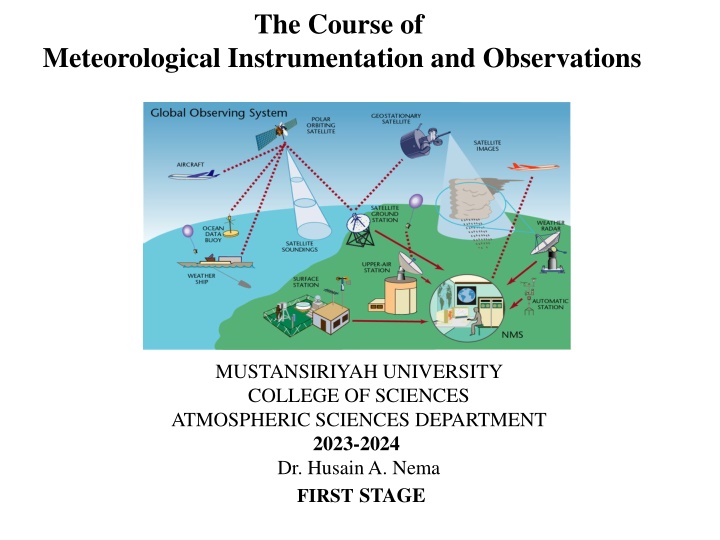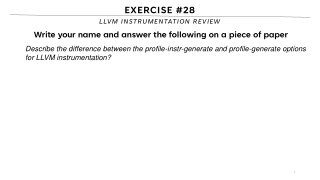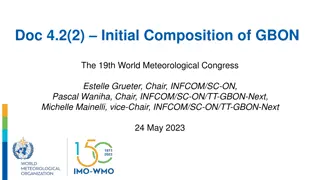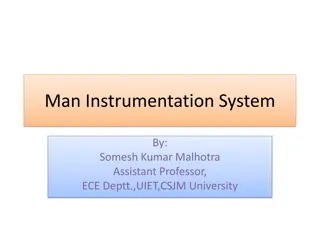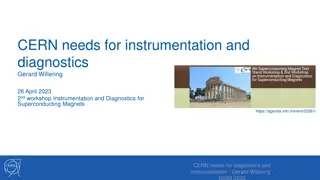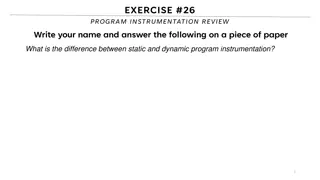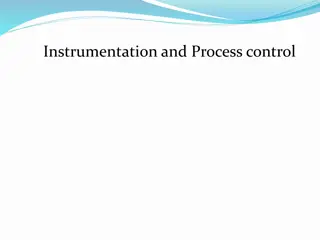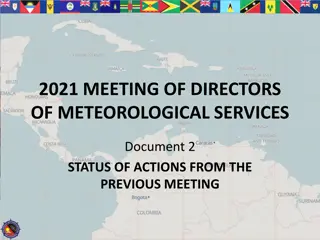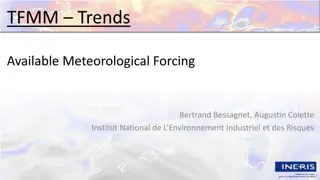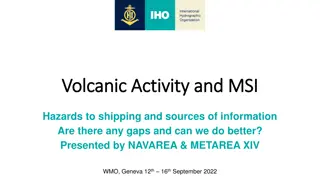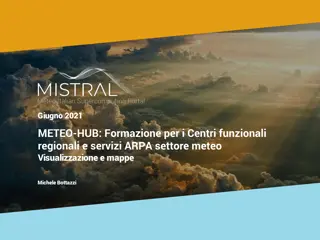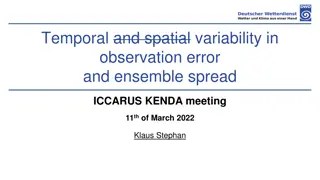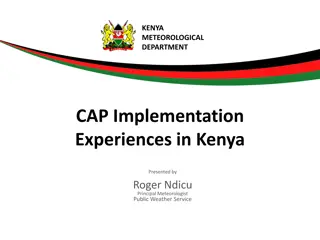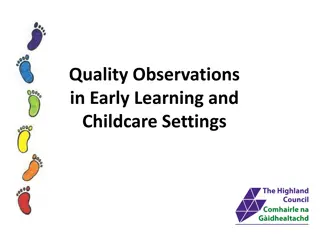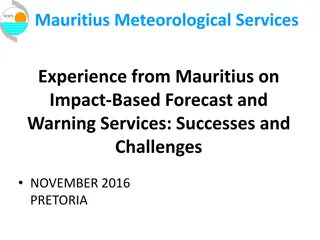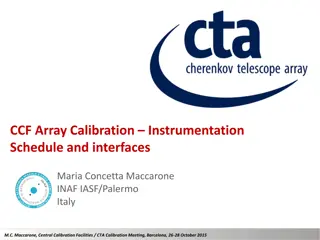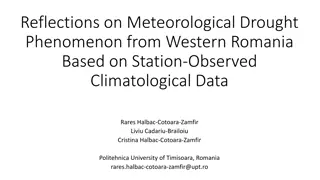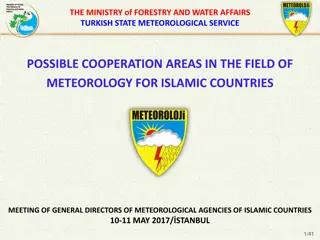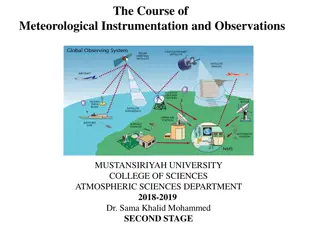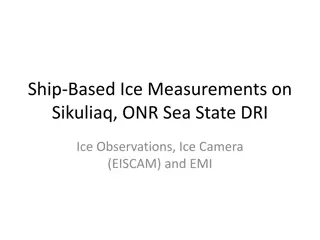The Course of Meteorological Instrumentation and Observations
This course covers principles of measurement and instrumentation for meteorological observations, including topics like wind measurement methods, temperature and moisture measurement, precipitation gauges, weather radar, satellite observations, and more. Meteorological observations are essential for weather analyses, forecasts, climate studies, local operations, hydrology, agriculture, research, and climatology.
Download Presentation

Please find below an Image/Link to download the presentation.
The content on the website is provided AS IS for your information and personal use only. It may not be sold, licensed, or shared on other websites without obtaining consent from the author.If you encounter any issues during the download, it is possible that the publisher has removed the file from their server.
You are allowed to download the files provided on this website for personal or commercial use, subject to the condition that they are used lawfully. All files are the property of their respective owners.
The content on the website is provided AS IS for your information and personal use only. It may not be sold, licensed, or shared on other websites without obtaining consent from the author.
E N D
Presentation Transcript
The Course of Meteorological Instrumentation and Observations MUSTANSIRIYAH UNIVERSITY COLLEGE OF SCIENCES ATMOSPHERIC SCIENCES DEPARTMENT 2023-2024 Dr. Husain A. Nema FIRSTSTAGE
Welcome Students! TO LECTURE ONE Principles of Measurement and Instrumentation
What are covered in this course? 1. Introduction to Met Instruments 6. Wind measurement Mechanical method Electrical method 2. Observing System 3. Temperature and Moisture measurement Basic principles Sensor types Response time 8. Clouds measurement 9. Upper atmosphere measurement 7. Radiation Basic principles Sensors 10. Weather radar 4. Precipitation measurement Rain gauges Radars for precipitation 11. Satellite observations 5. Pressure measurement Basic principles Sensors 12. Weather Maps and how to represent Weather Phenomena
Meteorological observations are made for a variety of reasons: for the real-time preparation of weather analyses, forecasts and severe weather warnings, for the study of climate, for local weather dependent operations (for example, local aerodrome flying operations, construction work on land and at sea), for hydrology and agricultural meteorology, for research in meteorology and climatology.
OBSERVING PARAMETERS PARAMETER SENSOR UNIT MEASURING RANGE Wind speed Anemometer m/sec, knot Degree 0..75 m/sec Wind direction Wind vane 0..360 o Air temperature Thermometer o C -60 o C..+60 o C Wet bulb temp. Thermometer o C 0...+40 o C Dew point Thermometer o C -60 o C...+50 o C Rel. Humidity Hygrometer % 0%...100% Soil Terre. Temp. Thermometer o C -60 o C...+70 o C Soil temp. Thermometer o C -50 o C...+70 o C Soil moisture Moisture sensor % H2O Undefined
OBSERVING PARAMETERS PARAMETER SENSOR UNIT MEASURING RANGE 600....1100 hPa Unlimited 0..1000 cm 0...100 mm/day 0...1500 W/m2 0...1500 W/m2 0...1500 W/m2 Undefined 120 W/m2 (threshold) Pressure Precipitation Snow depth Evaporation Global radiation Direct radiation Diffuse radiation Net radiation Sunshine duration Barometer Pluviometer Depth sensor Evap. Pool Pyranometer Pyrheliometer Pyranometer Pyranometer Heliometer hPa mm cm mm Watt/m2 Watt/m2 Watt/m2 Watt/m2 Hour
OBSERVING PARAMETERS PARAMETER SENSOR UNIT MEASURING RANGE Leaf wetness Wetness sensor Kg/m2, capacity% Undefined Soil heat flux Flux sensor Watt/m2 Undefined Lightning Lightning Detector Ceilometer Count 0....9999 Cloud height M, feet 30...25.000 m Visibility Transmissometer Forward scatt. M, km 25....50.000 m Present weather Pre. Weat. Sen. Phenomen a code ----
A measurement is a quantity that has both a number and a unit. 2.34 g 36.1 mL 996 hPa Measurements are fundamental to the experimental sciences. For that reason, it is important to be able to MAKE measurements and to decide whether a measurement is CORRECT.
We can make these observations in two ways: measurements obtained through direct contact with the respective object (basically you take measurements of the parameters right were you are) they measure the parameters from where they are located at that moment, Surface (stations, ships, or, buoys), or upper- air(rockets; balloons, and aircrafts) In situ measurement acquisition of information of an object or phenomenon, by the use of either recording or real-time sensing devices that are wireless, not in physical or intimate contact with the object. It has two types: active and passive remote sensing Remote sensing measurement
Active remote Sensing: Makes use of sensors that detect reflected responses objects that are irradiated from artificially-generated sources, such as radar(send out radiation, hoping to get it back to analyze it ). from energy Passive Remote Sensing: Makes use of sensors that detect the reflected or emitted electro- magnetic radiation from natural sources (wait for radiation to come to them so that they can analyze the data)
Steps needed to make measurements for a specific application: 1. Define and research the problem (literature review is advised). What parameters are required and what must be measured. What is the frequency of the observations that will be required? How long will the observations be made? What level of error is acceptable? 2. Know and understand the instruments that will be used (consider cost, durability, and availability). 3. Apply instruments and data processing (consider deployment, and data collection). 4. Analyze the data (apply computational tools, statistics, etc..).
Instruments and measurement systems determining the magnitude of a physical environmental parameter (ex. Temp.) sensing technology is able to respond the quantity to be measured a recording technique for the quantified response a method of quantifying the response Closely related is the need to evaluate how well the quantity has been measured, to provide an assessment of the associated uncertainty.
The sensor responds to the specific parameter measured. (In some cases, energy exchange by a transducer may also be required, to convert the sensor s response into something which can be more conveniently measured.) An amplifier is used to increase the magnitude of the changes produced by the sensor. Amplifiers operate on a variety of principles, for example mechanical, chemical, optical or electronic. As well as increasing the signal, an amplifier usually increases other random variations (noise) present as well. The meter provides the final readout in terms of a magnitude, and can be digital or analogue. A recording device of some form may be attached to the meter, such as a chart recorder, a computerized logging system or, more simply, an observer with a notebook.
